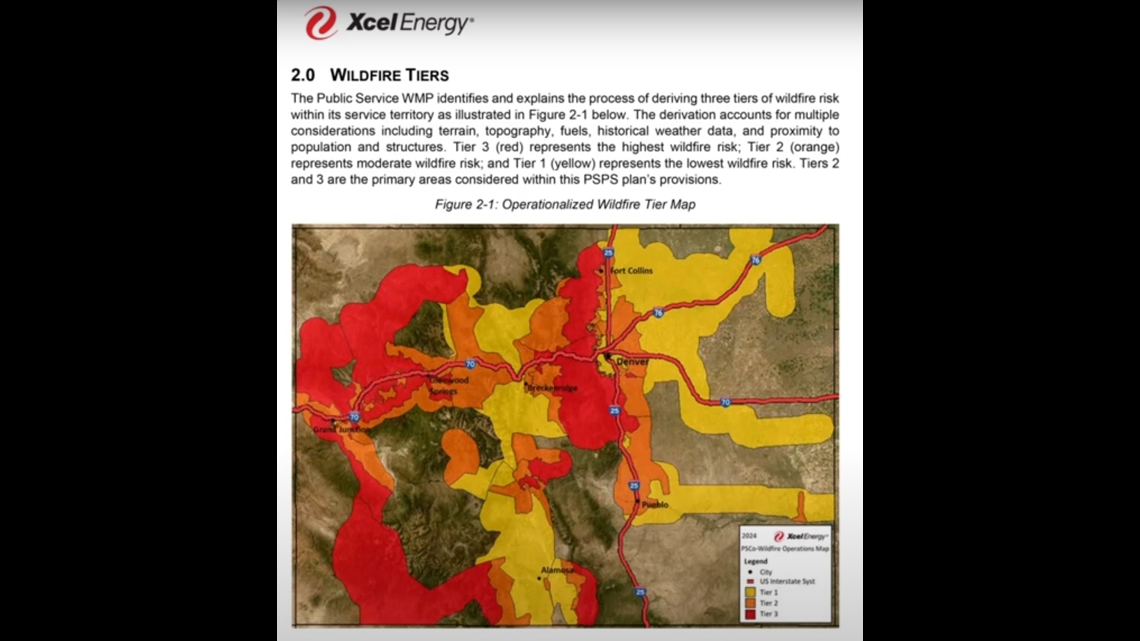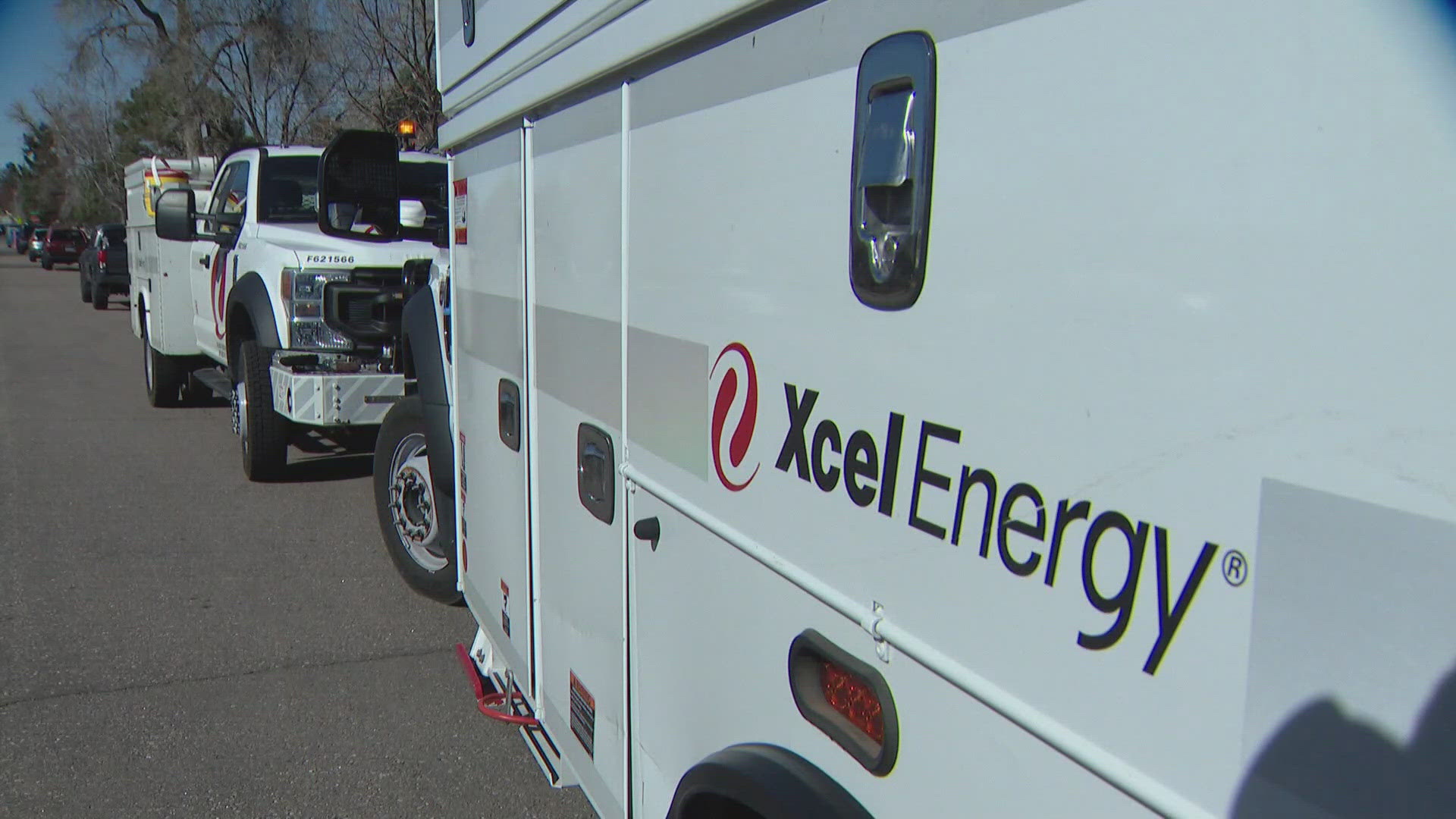DENVER — Xcel Energy has plans to prevent future wildfires. Yes, it includes the ability to shut off your power on purpose as a precaution. Yes, it includes burying miles of power lines underground. Yes, it costs a lot of money.
It would cost $1.9 billion over three years. The cost would be spread out across its one and half million customers.
“Nine dollars a month and less than 30 cents a day,” Robert Kenney, Xcel Energy Colorado President, said.
What do you get for $9 a month, if the Colorado Public Utilities Commission (PUC) approves the first version of the wildfire mitigation plan?
Over three years, Xcel said it would bury 50 miles of power lines for $200 million.
The company will add to its artificial intelligence camera system to detect wildfire smoke automatically.
Xcel also wants to hire 31 employees specifically assigned to a wildfire risk team. That would cost more than $15 million over three years.
Those are examples of what Xcel wants to do to minimize the chance its equipment causes a wildfire.
The wildfire mitigation plan also includes better communication and rules around public safety power shutoffs (PSPS), like what happened in April.
Among the hundreds of pages in 104 documents filed by Xcel on Thursday, there were at least two footnotes that basically said we will never know if a PSPS is successful.
“As a matter of practical reality, the company cannot know whether a PSPS will prevent a utility-related ignition. If a PSPS is not implemented and an ignition occurs, the ignition itself is not proof that a PSPS should have been implemented. Likewise, if a PSPS is implemented, the event itself does not prove that an ignition that would have otherwise occurred was prevented,” one footnote read.
“Everything that we're putting in there are for the purposes of protecting the public and mitigating the risk of an ignition of a wildfire. With respect to the PSPS, I think the footnote that you just read is another way of saying you can’t prove a negative,” Kenney said.
So, how does Xcel convince the PUC that a PSPS is something the company should be allowed to do?
“We have been able to demonstrate to our customers, our communities, regulators and policymakers after the April 6 event and the commissioner information meeting that we had, that this is a necessary tool to have in your toolbox. And, I think the proof of that fact was the documentary evidence that we showed and the pictures that we showed where we illustrated damage to our equipment, in the form of trees that had blown into our power lines and power lines that had been downed by the high winds,” Kenney said.
He also said that future PSPS would be smaller and, in turn, shorter.
During a meeting last month, PUC Commissioner Eric Blank asked Xcel if it could shorten the time it takes to bring the power back on.
Xcel must visually inspect each power line before it can be turned on. Blank suggested drones.
“Whether that's a foot patrol or the use of a drone or a helicopter, we have to actually look at the equipment to be certain that equipment hasn't fallen to the ground that you then reenergize and create the very risk that you're trying to mitigate,” Kenney said.
The cost of $1.9 billion over three years also includes maintenance; pole inspections and replacements and vegetation mitigation.
Is that not something Xcel customers already cover in their bills?
“This plan increases the size, the scope and the scale of the work that we are doing,” Anne Sherwood, Xcel Energy Colorado’s Vice President of Wildfire Mitigation, said. “We inspect approximately 20,000 distribution poles a year with our overhead line inspections. Due to the fact of climate change and increased risks in the state of Colorado, we will be inspecting approximately 44,000 poles in year one of execution of the plan.”
The wildfire mitigation plan also includes a risk map showing areas of the state that Xcel deems to be 'tier one' or low risk for wildfire, 'tier two' or moderate risk and 'tier three' or highest risk for wildfire.


“Those pole inspections will go more quickly and more frequently in tier three than they will in tier two, than it will a tier one. So, it informs the prioritization of the work that we're doing,” Sherwood said.
Kenney did not know where the 50 miles of power line undergrounding would take place but defended the $200 million estimate.
“Historically, we've underground it for primarily aesthetic reasons,” Kenney said. “This is targeted, specifically, for purposes of wildfire mitigation in those parts of our service territory where the risk-based modeling tells us that's indicated.”
There will be the usual outcry by the public wanting to know at what point Xcel makes less of a profit and does not charge customers for everything in the plan.
“The commission does set our return on equity,” Kenney said. “The nature of our business is that for every dollar that we earn, we invest several dollars back into the state of Colorado through system hardening and through other investments, whether it's this plan, whether it's the Clean Energy Plan, whether it's the Clean Heat Plan.”
Submitting the wildfire mitigation plan is step one of a process that could take one year. Going through the documents filed on Thursday, and there were 104 documents, is daunting.
“I think the burden is on us to be able to put forth the evidence so that the commission can make an informed decision. So, that's why you see so many documents,” Kenney said.
Xcel said it would hold town halls to inform customers.
“We've committed to going out into our communities and educate them about the plan, why we need the plan, doing virtual and in-person town halls,” Sherwood said.
Customers are defended by the Office of the Utility Consumer Advocate, which will likely push back on some of the costs and estimates.
The PUC will have the ultimate say on what the wildfire mitigation plan consists of and how much customers will have to pay.
“This plan is designed to protect public safety, to keep our customers and our community safe,” Kenney said.
SUGGESTED VIDEOS: Next with Kyle Clark

